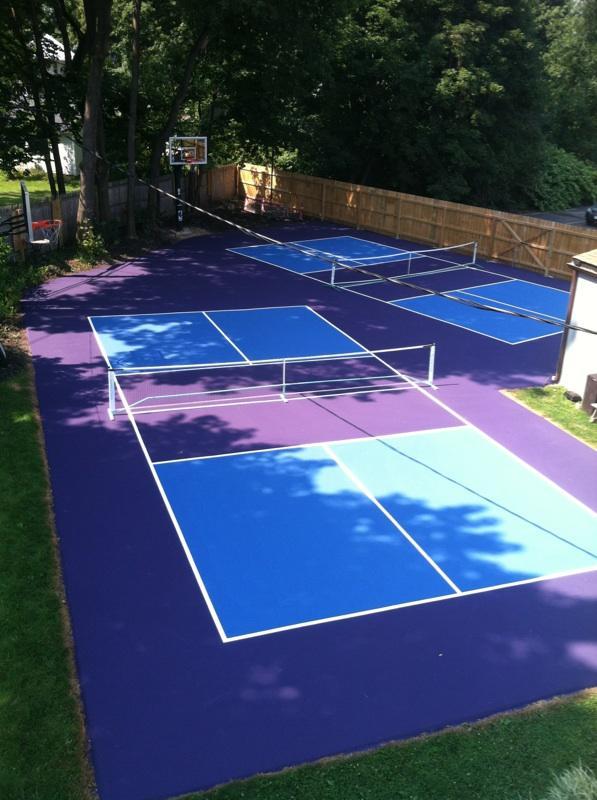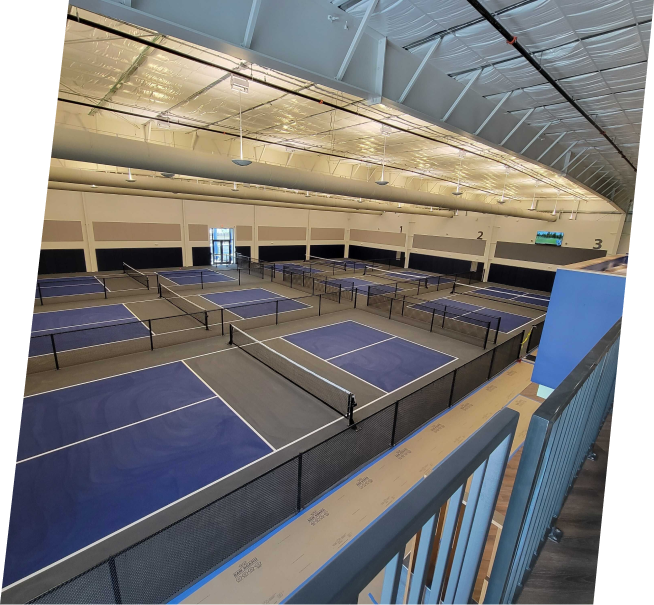A Comprehensive Overview to Designing the Perfect Pickleball Court for All Skill Degrees
Designing a pickleball court that caters to players of varying ability levels demands a multifaceted technique, encompassing necessary components such as court measurements, surface products, and ease of access functions. What specific considerations must be focused on to make sure an effective implementation?

Understanding Court Capacities
Comprehending the dimensions of a pickleball court is essential for both gamers and developers, as these specs make sure a regular and reasonable playing experience. A typical pickleball court measures 20 feet large by 44 feet long for both singles and increases play. The court is divided right into 2 equivalent halves by a net that stands 36 inches high at the sidelines and 34 inches at the center.
Secret features of the court consist of the non-volley area, typically referred to as the "kitchen area," which prolongs 7 feet from the internet on both sides. This area is crucial for regulating gamer movement and volleying, ensuring calculated play. Additionally, the solution locations on each side of the court are necessary, determining 10 feet wide and 15 feet deep, developed to fit correct serving techniques.
Bordering the court, an area of a minimum of 10 feet should be designated as the security zone, allowing players sufficient space to relocate and avoid injuries throughout play. Complying with these dimensions not just promotes fair competitors but additionally promotes security and pleasure for all participants, making it vital for any type of pickleball court design.
Selecting the Right Surface
The selection of playing surface for a pickleball court substantially influences the video game's characteristics and player experience. Selecting the suitable product is essential for making sure gamer performance, comfort, and safety and security. Usual surface areas include asphalt, concrete, and specialized sporting activities floor covering.
Asphalt is a prominent option because of its price and longevity. It supplies a consistent playing surface however can be difficult on joints over expanded play. Concrete, while similar in toughness, uses very little adaptability, possibly resulting in raised effect on gamers' bodies.
For an extra cushioned experience, several centers opt for customized sports flooring, such as synthetic surface areas or modular floor tiles. These materials typically consist of shock-absorbing properties, minimizing the threat of injuries and boosting gamer convenience. Such surface areas can boost round bounce consistency, which is necessary for fair play.
When selecting a surface, think about elements such as environment, maintenance requirements, and the strength of play. An appropriate surface not just boosts gameplay but also adds to the long life of the court itself. Inevitably, comprehending the nuances of different materials will certainly aid in producing an optimal pickleball environment customized to various skill levels.
Optimal Court Design
An ideal court format is necessary for taking full advantage of both gamer efficiency and spectator pleasure in pickleball. The dimensions of a standard pickleball court are 20 feet wide by 44 feet long for increases play, preserving a clear boundary that improves gameplay. The web, positioned at 36 inches high at the sidelines and 34 inches in the center, is vital for maintaining the characteristics of the game.
Integrating designated locations around the court for gamers to relocate easily is vital. A minimum of 10 feet of clearance on all sides of the court is recommended to stop collisions and provide space for viewers. Furthermore, positioning plays a substantial function; the court should ideally be aligned north-south to reduce the influence of sun glow on players throughout height hours.
Efficient spectator placement is similarly vital. Elevated checking out bleachers or areas positioned behind the sidelines can improve the experience while ensuring safety. Last but not least, clear and noticeable court markings help in gameplay, with contrasting colors for limits and non-volley areas that mark important areas for gamers. Overall, a properly designed court format cultivates an engaging setting for both viewers and players.

Availability Factors To Consider
When creating a pickleball court, making certain access for all gamers, including those with specials needs, is paramount. A thoughtfully developed court visit this site right here can foster inclusivity and encourage engagement from individuals of differing abilities.

Accessibility paths to he has a good point the court have to also be very carefully intended. Make certain that paths leading to the court are large enough for mobility device individuals and are furnished with ramps where essential. Signage needs to be big and clear sufficient to be quickly reviewed.
In addition, seating areas need to be designed to permit very easy accessibility to and from the court. This consists of providing designated rooms for viewers that may have flexibility challenges.
Last but not least, make certain that restroom centers nearby meet access standards. By thinking about these elements, you can produce a pickleball court that rates and functional for everyone, thereby promoting a vibrant and varied area of gamers.
Upkeep and Upkeep
Appropriate maintenance and maintenance of a pickleball court are necessary for guaranteeing ideal having fun conditions and extending the life expectancy of the facility. Regular examinations should be performed to determine and resolve any kind of damages or put on, such as fractures in the surface or loosened netting. These issues, if left neglected, can adversely impact gameplay and security.
Surface upkeep is essential; courts must be cleaned up often to remove debris, leaves, or dirt that can affect grip. For hard courts, routine pressure cleaning is recommended to maintain surface integrity and aesthetic appeals. If your court is made from softer products, such as asphalt, resurfacing or sealing may be required to protect versus weather-related wear.
In addition, web elevation and tension must be inspected frequently, as incorrect setups can alter gameplay. Preserving bordering areas, consisting of fence and lighting, is similarly vital for guaranteeing a delightful and risk-free setting.
Final Thought
In verdict, the layout of a perfect pickleball court necessitates a meticulous method that encompasses proper measurements, suitable surface products, and thoughtful design. By adhering to these guidelines, the best pickleball court can be produced, advertising satisfaction look these up and athletic growth for gamers of differing skill degrees.
Creating a pickleball court that provides to gamers of differing ability levels demands a multifaceted approach, incorporating essential aspects such as court measurements, surface area materials, and availability attributes.Recognizing the measurements of a pickleball court is important for both developers and gamers, as these specs make sure a constant and fair having fun experience.The option of playing surface area for a pickleball court substantially influences the game's characteristics and player experience.An optimum court design is essential for making the most of both gamer efficiency and viewer pleasure in pickleball. By sticking to these guidelines, the perfect pickleball court can be created, promoting pleasure and sports growth for players of varying ability degrees.